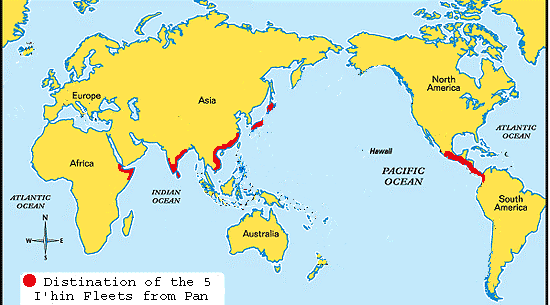Applying knowledge about DNA to the origins of human ancestry has
produced some very interesting results which have led researching
scientists to revise previous theories of the origins of modern man
and the various ethnic groups of humans––not least the origins of the
Native Americans.
While there are sufficient common DNA markers in today’s populations to indicate that there have been various migrations from Asia to the Americas since 15,000 years ago, there are also DNA markers that are unique to American Natives that diverged as early as 30,000 years ago.
This DNA data indicates that the common ancestors of Asians and Americans separated far earlier than 15,000 years ago, and this is in accord with the account given in Oahspe, where we find that the small groups of surviving I'hins from the continent of Pan landed in the five divisions of the earth around 25,000 years ago and mixed with the indigenous races to form the I'huans (a Proto Modern Man) some 24,000 years ago.
Because the Bering land connection remains the favourite theory for the population of the Americas by the first humans, some scientists trying to reconcile new genetic information attempt to hypothesise a period of 15,000 years where the ancestors of the American Natives lived isolated from the Asians before populating the Americas via the Bering land connection about 15,000 years ago. (See extract below)
However, according to Oahspe, the ancestors of the modern American natives
landed on the west coast of Central America, around Guatemala around 25,000
years ago. From there
they spread North and South, into both North America and South America,
and this would account for what appears to be a very rapid colonization,
especially to those who believe the entry point was at the extreme north at the
Bering land connection.

Oahspe: The Lords' First Book, 1.
||44. And the Lord said: I numbered them (the I’hins)
that were saved, and there were twelve thousand four
hundred and twenty; and these were all that remained of
the first race of man that walked on two feet.
45. Behold, I will carry them to all the divisions
of the earth, and
people it anew with the seed
of my chosen.
46. And Jehovih blew His breath upon the ships of
His sons and
daughters; blew them about upon the
ocean; blew them to the east and
west and
north and south.
47. By the will of God were the ships congregated
into four fleets;
thirty-four ships into each fleet, save two
ships which were carried
in a fleetto themselves.
48. The Lord said: I will name the fleets of
my chosen, and their
names shall be everlasting on the
earth. And the Lord named them
GUATAMA (the Americas),
SHEM (India), JAFFETH (China), HAM (Africa), and
YISTA (Japan).||
http://www.sciencedaily.com/releases/2007/10/071025160653.htm
29 Oct, 2007, Science Daily, Extract:
|| Questions about human
migration from Asia to the Americas have perplexed anthropologists
for decades, but as scenarios about the peopling of the New World
come and go, the big questions have remained...... A team of 21
researchers, led by Ripan Malhi, a geneticist in the department of
anthropology at the University of Illinois, has a new set of
ideas........
"Our phylogeographic analysis of a new mitochondrial genome dataset allows us to draw several conclusions," the authors wrote.
"First, before spreading across the Americas, the ancestral population paused in Beringia long enough for specific mutations to accumulate that separate the New World founder lineages from their Asian sister-clades." (A clade is a group of mitochondrial DNAs (mtDNAs ) that share a recent common ancestor, Malhi said. Sister- clades would include two groups of mtDNAs that each share a recent common ancestor and the common ancestor for each clade is closely related.)
Or, to express this first conclusion another way, the ancestors of Native Americans who first left Siberia for greener pastures perhaps as much as 30,000 years ago, came to a standstill on Beringia – a landmass that existed during the last glacial maximum that extended from Northeastern Siberia to Western Alaska, including the Bering land bridge – and they were isolated there long enough – as much as 15,000 years – to maturate and differentiate themselves genetically from their Asian sisters.
"Second, founding haplotypes or lineages are uniformly distributed across North and South America instead of exhibiting a nested structure from north to south. Thus, after the Beringian standstill, the initial North to South migration was likely a swift pioneering process, not a gradual diffusion."........
The team identified three new sub-clades that incorporate nearly all of Native American haplogroup C mtDNAs – all of them widely distributed in the New World, but absent in Asia; and they defined two additional founder groups, "which differ by several mutations from the Asian-derived ancestral clades."
What puzzled them originally was the disconnect between recent archaeological datings. New evidence places Homo sapiens at the Yana Rhinoceros Horn Site in Siberia – as likely a departure point for the migrants as any in the region – as early as 30,000 years before the present, but the earliest archaeological site at the southern end of South America is dated to only 15,000 years ago........||